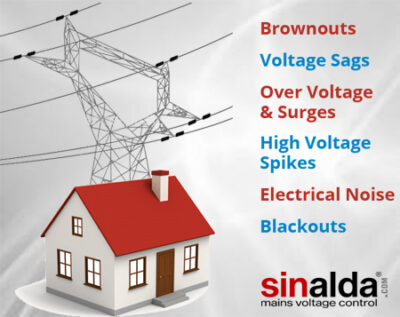AC Voltage Stabilisers / Regulators & Power Conditioners for the Home.
Traditionally the need for the regulation and control of the incoming mains supply has been considered the province of business and government organisations.
However, in recent years, with a lack of general investment in new generation capacity and the failure to replace decommissioned fossil fuel and nuclear power stations, existing supply networks are all too often struggling to keep up with the demand of the new power hungry digital age and many households are now witnessing a marked general deterioration in the quality of power they receive.

To compound the problem, many of the appliances we now use in our household have changed in nature, becoming far more digitally based and as a result more voltage sensitive. It is now not uncommon for the modern home to be running state of the art heating, cooling and refrigeration systems, high-tech computer networks, and the latest in home entertainment systems. If you allow the mains supply to ‘fry’ any of the circuits in these systems you can, more or less, be guaranteed an extremely expensive repair bill.
Of course in less developed countries, where historically the national supply infrastructures have always tended to struggle to satisfy demand, the need for voltage protection is even more acute and for many households, considered far more of a priority than those in more advanced economies.
Taking all this into account, it is not really surprising that more and more homes, in all parts of the world, are in need of protection against the vagaries of the mains supplies that feed them.
At Sinalda UK our popular SVS & mSVR ranges of single and three phase automatic voltage stabilisers are ideally suited for improving the power quality in your home.
How to select the most appropriate Voltage Stabiliser for your needs
Here at Sinalda UK we are regularly requested to supply Voltage Stabilisers for use in the home.
In order for us to be able to offer the most cost efficient voltage stabiliser solution there are always 6 Key Questions which we must ask a client before we can make a suitable recommendation.
In order to select the most appropriate solution it is first necessary to determine whether protection is required for the entire house, just certain key essential electrical circuits or simply designated individual pieces of equipment.
As you would expect, protection for the entire house or certain key circuits is the more costly options, but in some less developed countries, where the incoming mains supply is persistently unreliable, they are the only real options available.
In most instances this will be Single Phase, but for larger residential or semi-commercial properties this may not always be the case.
In Europe and most countries outside the US this will be in the range of 380V to 415V for three phase supplies and 220 to 240V for single phase supplies. In the US, and countries whose supply infrastructures are based on the American model, the ranges will be 190 to 240V for three phase supplies and 100 to 127V for single phase.
Three phase supplies will normally be 4 Wire (3 Phase + Neutral) in nature, but a 3 Wire (Three Phase with NO Neutral) configuration might be found.
Most single phase supplies will be 2 Wire in nature, but in the USA a split single phase configuration (3 Wire) is quite commonly found in residential property. In such situations a dual (220V to 240V and 110 to 120V) stabiliser output will be required.
The quickest way of determining this is to actually find out the power ratings of the equipment to be protected. Usually the appliances will have this information recorded on their rating plates.
Where protection is required for an entire home, the simplest way of determining the required stabiliser’s maximum rating is to check the circuit breaker or fuse rating on the incoming mains supply.
If you only wish to protect certain electrical circuits in the house, the easiest way to get the loading figure is to check the ratings of the input circuit breaks or fuses on the relevant circuit in the house’s electrical distribution box.
When protecting only certain circuits, you are recommended, for ease of Voltage Stabiliser installation, to split these circuits off into a dedicated sub-distribution board, with its supply fed through the voltage stabiliser from a dedicated feed from the main distribution panel.
If you have a really poor mains supply, you probably already have a good idea as to the extent of the problems you are experiencing.
In situations where this is not the case, you can, these days, source inexpensive (less than US $50) power monitors from the likes of Amazon that simply plug into a power outlet socket, allowing you, over time, to monitor the voltage levels in your home.
As a rule of thumb, in situations where there is a reasonably good mains supply, a stabiliser offering an input voltage window of ±15% from the nominal voltage will usually be more than adequate.
However, in more remote locations, or in countries where the national supply infra structure is less developed, variations of ± 20%, or greater, may be required to be covered by the stabiliser.
For the stabiliser to offer the highest level of protection, and deliver optimum energy efficiency in the home, we normally recommend a client looks for accuracy on their selected / required output voltage of ±1%.
However, given that the cost of the stabiliser is linked to the size of the input voltage range it has to handle, if the client requires, or is willing to accept, a lower output voltage accuracy, the input window of the stabiliser can be widened proportionally and prove to be a more cost efficient solution than buying a more expensive wider input voltage window model offering an output accuracy of ±1%.
Please Note: All electrical installation work should only be carried out by duly qualified electricians.

